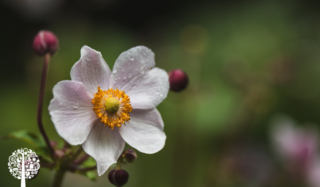Welcome to Plant of the Month, a new series featuring a perennial plant rooted in my garden and some tips and tricks I’ve learned about making it a star.
For the inaugural plant of the month, I chose one of my favorites, fall anemones.

Part of the ranunculus or buttercup family, anemones include more than 120 species that bloom in spring, summer, and autumn.
The fall or Japanese/Chinese anemones come in shades of pink, rose, and white with single or double-saucer-shaped flowers and are a whimsical addition to the garden when so many other perennials are fading for the season.
Perfect for the cottage or woodland garden, fall anemones are often sold in late summer in garden centers. With a reputation for blooming for up to eight weeks, it’s impossible to resist this September wonder!
Plant Hardiness
Most varieties of fall anemone (anemone hupehensis and anemone x hybrida) are hardy to at least zone 5 (-29°C), with some varieties such as Honorine Jobert even hardier to zones 3 and 4 (-35°C to -40°C).

In a rainstorm and at night, the petals of a fall anemone will close and nod down to protect the bloom; that’s pretty amazing if you ask me. They do not care about wind as long as they are tied up or staked.
Light and Soil
Fall anemones prefer sun or part shade and moist, well-draining soil. Make this plant happy by adding a top layer of mulch or compost to insulate its roots and prevent water from evaporating on hot summer days.
Disease and Pest-Resistant
Aphids, slugs, deer, rabbits, and squirrels ignore anemones. Fall anemones are also resistant to powdery mildew and black spot.
Pollinators Love It
This is one of my favorite reasons for having fall anemones in the garden. Bees compete with butterflies and even hummingbirds for a good swig of the plant’s nectar. The more pollinators in the garden, the better for the planet.
Drawbacks: Containers and Size
There are a few things to be cautious about regarding fall anemones.

In my experience, they don’t do well in containers. Anemones have an extensive root system and are spread by rhizomes, with some bigger varieties sending out new shoots up to a meter away from the parent plant. They will quickly feel confined in a container and won’t produce as many blooms.
This spreading habit causes many varieties to grow up to two and a half meters tall and spread just as far. I like the bigger types, especially the white fall anemone. To keep the plant from overtaking the garden, I continually pull the new shoots that spring out of the ground throughout the growing season.
However, there are dwarf varieties, such as Little Princess, with a growing habit of 60 cm tall and wide. These are perfect for small planter boxes on a patio.
Whatever variety of fall anemone you choose, I hope you fall in love with this September star. See you next month as we grow and garden together!